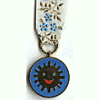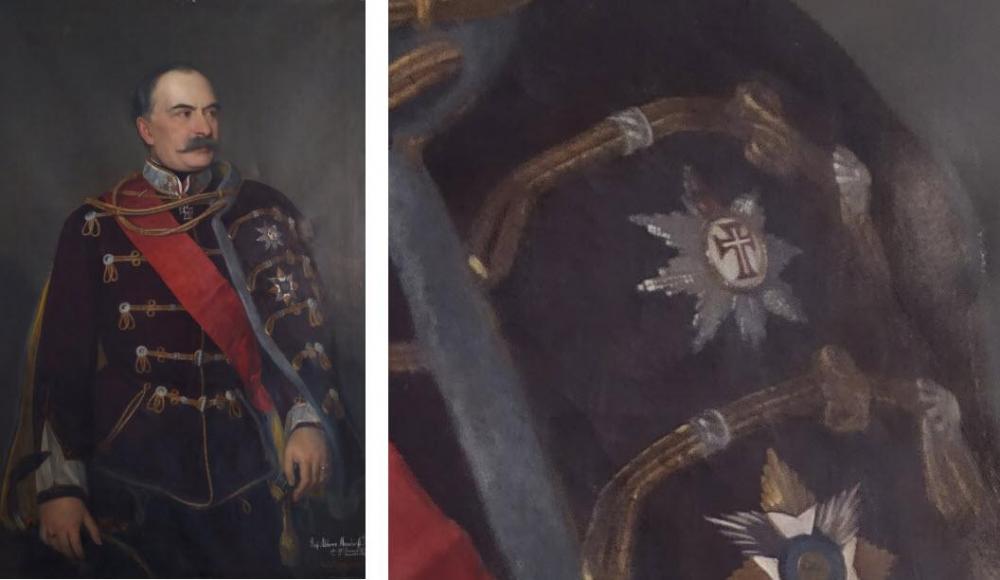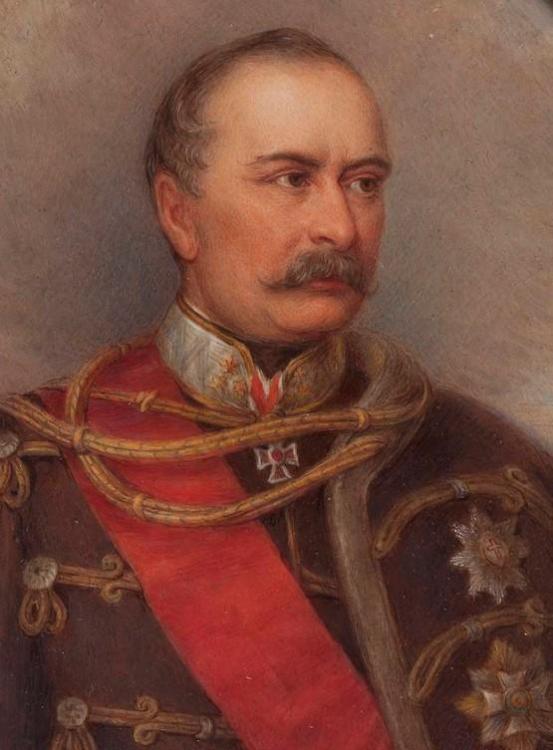-
Posts
679 -
Joined
-
Last visited
-
Days Won
2
Content Type
Profiles
Forums
Blogs
Gallery
Events
Store
Posts posted by Lukasz Gaszewski
-
-
A different kind of stuff, but notice that the prince's star of the Black Eagle is surrounded by the English Garter.
0 -
The photo did not come through. Please post it again.
0 -
On 21/02/2020 at 15:49, ArHo said:
I would say that the upper one, with the eagle sittig quite high, looks very similar to military academy badges I saw online.
Well, all those badges looked quite similar. To me they look more like academic or society badges. I am not even sure if the gentleman was a military. He looks fairly civilian to me. If he was a soldier, his orders would probably have swords.
The neck decoration is the Order of St. Vladimir 3rd Class and the star is of St. Anne 1st Class.
To me he looks like a high-ranking state official (a state councillor or higher), or a university professor.
0 -
On 21/02/2020 at 13:54, Solomon said:
From 1898 until 1919 I count 21 years of service.
But war time service was counted double (1914-1918 = 8 years instead of 4 years), so the countable years of military service was in 1919 already >= 25 years (17 years of normal service + 8 years of war service = 25 years).Well, it does make sense. You can say he got it at the last possible moment.
Your idea of the swords on the ring seems sensible, too. Note that on the miniature chain the cross has "standard" swords instead (I am not even sure if miniature crosses of the Lippe House Order with swords on ring were ever manufactured).
0 -
Splendid! It is a medal bar for civilian attire, with decorations running from right to left.
One odd thing: if Metze was born in 1878 (btw. 1878-1964 does not match with 84 years of living) how could he receive a cross for 25 years of service? Not too young?
0 -
A very sad news. RIP.
0 -
Judging from the obverse, the oblong eye and the arrangment of stripes on the ribbon, it can be the Friedrich-Luisen-Medaille of Baden of 1906.
0 -
On 29/01/2020 at 16:35, 91-old-inf-reg said:
On this photo he is wearing a Russian uniform (so is the man behind in the middle). The sash (and upper star) is of the Order of St. Andrew.
According to The Titled Nobility of Europe (1914), the Großherzog was the knight of the following orders:
- Black Eagle of Prussia
- St. Hubert of Bavaria
- St. Andrew of Russia
- Annunciation of Italy
- Elephant of Denmark
- Rue Crown of Saxony
- Grand Cross of the Victorian Order of Great Britain (1907).
0 -
On 03/01/2020 at 19:49, JohanH said:
How common are Polonia Restituta orders for foreigners outside of the eastern bloc?
Quite common and in all classes. Remember that at that time (1966) Polonia Restituta was the only "diplomatic" order of merit of the country and People's Poland maintained diplomatic relations with almost all countries of the world. Not only those of the eastern bloc. The situation changed diametrically in 1974, when the Order of Merit of the People's Republic of Poland was established. From then on, Polonia Restituta started being conferred exclusively upon Polish citizens, and to foreign nationals in exceptional cases only.
0 -
Great, Megan! I felt somehow you would make this offer...
0 -
9 hours ago, Megan said:
The site owner passed away a while back. I'm thinking the domain name registration might have expired.
Very sorry to hear it. It was probably the best site about Scandinavian (particularly Swedish) ODMs. Axel did a great job indeed. I archived the site some three years ago, and wanted to do it again now, just before the New Year. Still, due to its size and complex structure the site was a nightmare to archive, so I decided to put it off until after the New Year and then it was already unavailable. You never know what you are going to miss. It seems that what has been stored on webarchive.org is just a small fraction of the original site. Three years ago I archived over 9,000 photos of Swedish medals alone! Axel's passing away is a huge loss to all ODM specialists and enthusiasts. Hopefully the site will be revived one day.
0 -
Anybody know?
0 -
Does anybody know what has happened to the medalj.nu website? It is one of the most valuable sites regarding Scandinavian ODM. I cannot access it since the beginning of the year. It would be the great loss if the site was down.
0 -
I believe that the new system of military ranks was introduced by Lege 80 of 1995:
http://legislatie.just.ro/Public/DetaliiDocument/6151
The new rank insignia were generally based on those used before WWII, yet with some modifications. As far as I remember, rank insignia of generals initially resembled those used in the Bundeswehr and they were modified again a few years later.
0 -
It is easier with the second photo. The decorations on the ribbons may be as follows:
- Russian Order of St. Vladimir 4th Class with swords
- Montenegran Order of Danilo 5th Class
- Russian Order of St. Anne 3rd Class with swords
- Russian Order of St. Stanislas 3rd Class with swords
- Montenegran Obilich Medal (?)
The neck decoration is probably the Russian Order of St. Vladimir 3rd Class
The stars are from:
- Montenegran Order of Danilo
- Russian Order of St. Stanislas
- Italian Order of the Crown
The photo seems to be after somebody's funeral (black armband). If we could find out whose, we could date it.
0 -
5 hours ago, Trooper_D said:
Give the gentleman a cigar

If you click on the link below and right click the small image of the portrait above that appears there, then select 'Open image in a new tab' (in Google Chrome; other browsers may differ) you will be presented with a very large version - too large to post here, I think.
http://www.zamekboskovice.cz/rod-mensdorff-pouilly
Incidentally, has anyone any thoughts as to the star below the one in question?
A perfect shot Trooper_D! Please do accept another cigar from me, too

I also thought of the Order of Christ, but the cross on the star looked a bit too different to me. I was also not sure if at that time (my portrait was dated to 1865) the eight-pointed star was already in use. It seems that the painting at the Boskovice palace was exactly that from which my miniature was made.
Yes, the other star is of the Order of the House of Saxe-Ernestine (from which Albert, Prince-Consort of Queen Victoria also , originated). To make the things entirely clear, the neck decoration is the Commander Cross of the Austrian Order of Leopold - but I think it is obvious to everybody here.
The funniest thing is that a few years ago I myself had the opportunity to visit the palace in Boskovice (which is located north of the City of Brno in the Czech Republic), but I completely do not remember if the portrait was there or not. Anyway, I would be delighted to learn who the painter was. I could not find it anywhere on their site.
Trooper_D, Alex and laurentius, thanks once again for your assistance.
Regards,
Lukasz
0 -
Nice to meet you again, too
 0
0 -
Hello All,
This is the portrait of count Alfons Friedrich von Mensdorff-Pouilly in the uniform of a Hungarian cavalry colonel. I am interested in your opinions about the sash and the upper star. What can they be from? I have some theory but I do not want to impose my view. I will owe a lot for assistance.
Regards,
Lukasz
0 -
Ribbon bars did exist in both German Empire and Third Reich and you can find lots of photos of German military wearing them, even on this forum. Still, those ribbon bars were treated stricltly as replacement only for the decorations and medals worn on the ribbons on the left chest, consequently higher classes were not denoted at all and were usually worn in full. In the Third Reich upper classes of some orders could be replaced by ribbon bars, but that regarded foreign awards only. Ribbon bars for the upper classes of German decorations appeared first in the Federal Republic. Thus you are unlikely to find the ribbon bar to a Pour le Merite, either in the German Empire, or in the Third Reich.
Hope this will help.
0 -
The LOM looks quite strange and it does not seem genuine.
0 -
It would probably be easier to give advice if we could see the medals.
0 -
On 23/03/2019 at 14:56, IrishGunner said:
My guess some kind of award for a cavalry horse competition.
And you are right. It reads: X International Offic[er] Horse Comp[etition], Warsaw 1937.
0 -
I agree, it seems original! Its recipient must have been engaged in the underground (most probably left-wing) movement during the war, then drafted in the People's Army and served during the Berlin Operation (he did not need to participate in capturing Berlin to receive the medal). After the war he served either in the Militia (the behind the Iron Curtain counterpart of other countries' Police) or in security organs, as indicated by the last three medals.
The Fire Fighting medal should come last, but the recipient decided to put it higher, probably because it was gold, compared to the remaining medals in silver or bronze. Other than that, the sequence is perfect.
The double Medal for Victory and Freedom was a rare thing to see, but it happened.
Regards
0 -
It is not Polish, it is Austrian, namely from the Tyrol. It is the Pater-Haspinger-Medaille of the Bund der Tiroler Schützenkompanien, for 15-year membership.
It is the Tyrolean eagle, albeit indeed very similar to the Polish one.
Regards
0







Picture - old gentleman, high ranking orders, help appreciated!
in Russia: Imperial
Posted
Respect!